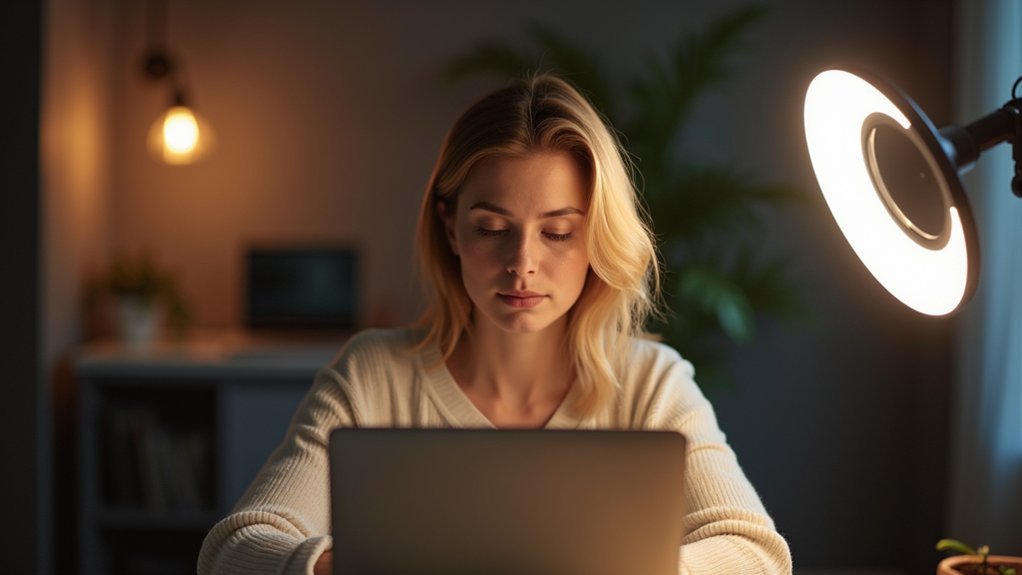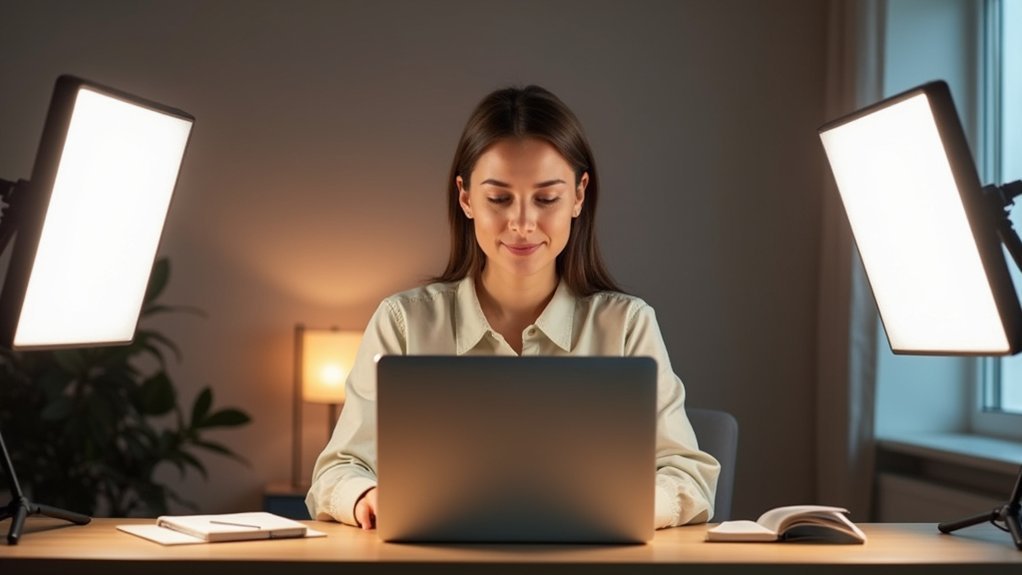You’ve probably noticed how some online instructors look crisp and professional while others appear washed out or shadowy during virtual classes. Lighting can make or break your digital presence, transforming an ordinary Zoom session into a compelling visual experience. Understanding the nuanced techniques of strategic illumination isn’t just about equipment—it’s about creating a visual narrative that captures and maintains student attention. Want to know how professional educators craft their perfect virtual classroom aesthetic?
Key Takeaways
- Position your primary light source at a 45-degree angle to create soft, flattering illumination that minimizes unflattering shadows during virtual classes.
- Use a ring light or LED panel with adjustable color temperature (3,200-5,600 K) to achieve natural, professional-looking lighting that enhances your on-camera appearance.
- Implement a three-point lighting setup with key light, fill light, and backlight to create depth, reduce harsh shadows, and provide a polished visual presentation.
- Choose neutral background colors and soft, diffused lighting to create a clean, professional environment that keeps the focus on you during virtual instruction.
- Select lighting equipment with a high Color Rendering Index (CRI 90+) to ensure accurate color representation and a more engaging, true-to-life video experience.
Essential Zoom Lighting Principles

While virtual teaching demands technical proficiency, mastering essential Zoom lighting principles can dramatically elevate your online presence. A three-point lighting setup is critical, strategically positioning a key light, fill light, and backlight to create depth and professional video quality. You’ll want to adjust color temperature between 3,200 to 5,600 K to replicate natural daylight, ensuring soft, even glow across your face. Invest in adjustable lighting fixtures that allow precise positioning, enabling you to maintain consistent illumination regardless of movement during virtual classes. Position your primary light source at a 45-degree angle in front of you, which minimizes harsh shadows and provides balanced, flattering coverage. By implementing these technical lighting principles, you’ll transform your video presentation from amateur to polished, creating a more engaging and professional visual experience.
Camera Positioning and Angle Strategies

Effective camera positioning transforms virtual teaching from mundane to compelling. Your lighting for video depends critically on camera angle strategies that enhance professional appearance. Position your camera at eye level or slightly above, maintaining an arm’s length distance to center your face precisely within the frame. A tripod guarantees consistent framing during Zoom calls, allowing you to experiment with subtle 30-45 degree angles that create visual depth.
When setting up your virtual classes, prioritize an engaging angle that mimics face-to-face interaction. By thoughtfully adjusting your camera’s placement, you’ll create a more dynamic and connected learning environment. The right positioning isn’t just technical—it’s about crafting a visual experience that draws students into your digital classroom, making every interaction more impactful and professional.
Choosing the Right Lighting Equipment

Selecting the right lighting equipment can transform your virtual teaching from amateur to professional. When choosing light sources for video calls, consider these key factors:
- Opt for lighting equipment with adjustable color temperatures (3,200 K to 5,600 K)
- Implement a three-point lighting setup to eliminate harsh shadows
- Invest in ring lights or LED panels for diffused, flattering light
- Use fixtures with mounting options for precise positioning at ideal angles
- Select lights with a Color Rendering Index (CRI) of 90+ for accurate color reproduction
Your lighting strategy should prioritize even illumination and natural-looking skin tones. Portable, versatile light sources allow you to create a professional visual environment that enhances your virtual teaching presence, ensuring you look crisp, clear, and engaging during online classes.
Creating a Professional Background Environment

Because virtual teaching demands a polished visual presentation, your background environment plays a critical role in maintaining professional credibility. Select neutral wall colors to enhance lighting conditions and prevent unflattering color casts. Position your desk against a plain backdrop to guarantee a consistent aesthetic during video calls.
| Element | Purpose | Recommendation |
|---|---|---|
| Wall Color | Lighting | Neutral tones |
| Backdrop | Visual Focus | Solid, uncluttered |
| Personal Touches | Atmosphere | Minimal, professional |
| Lighting | Ambiance | Soft, diffused |
| Composition | Professional Appearance | Clean, intentional |
Integrate subtle personal touches like framed artwork or a single plant to create warmth without distraction. Utilize soft, diffused lighting to elevate your background’s professional appearance while maintaining a flattering visual environment that keeps the viewer’s attention on your content and presentation.
Lighting Techniques for Enhanced Video Quality

Mastering three core lighting techniques can transform your virtual teaching presentation from amateur to professional. Your video quality hinges on strategic illumination that enhances clarity and engagement:
- Position key light sources at precise 45-degree angles
- Utilize adjustable LED lights with 3,200-5,600 K color temperature
- Implement a three-point lighting setup for dimensional depth
- Eliminate backlighting by covering windows behind you
- Test and calibrate brightness levels before each virtual interaction
Crafting a sophisticated lighting setup requires intentional technical precision. By strategically arranging your key light, fill light, and backlight, you’ll create flattering illumination that eliminates harsh shadows and presents a polished, professional appearance. Your virtual classroom presence becomes more dynamic and engaging when lighting is meticulously managed, ensuring viewers remain focused on your instruction rather than visual distractions.
Advanced Lighting Solutions for Virtual Presentations
Building upon foundational lighting techniques, advanced virtual presentation lighting demands sophisticated technological solutions that elevate your digital classroom experience. Strategically positioning adjustable LED panel lights at a 45-degree angle enables precise control over key light, fill light, and backlight configurations. Your ring lights can effectively diffuse harsh illumination, creating even facial illumination while minimizing distracting shadows. Select LED panels with versatile color temperature ranges (2,900-7,000 K) to match your ambient environment and personal aesthetic preferences. Complement your primary lighting setup with subtle ambient lights that enhance mood without overshadowing task lighting. By integrating these advanced solutions, you’ll transform your virtual presentation from mundane to professional, ensuring viewers remain engaged and focused on your content rather than technical limitations.
Frequently Asked Questions
What Lighting Makes You Look Best on Zoom?
You’ll look best on Zoom with soft, natural light positioned at a 45-degree angle, using softboxes or a ring light near your window, maintaining 3,200-5,600K color temperature to eliminate shadows and enhance face illumination.
What Is the Best Way to Set up Lighting for Zoom?
You’ll want soft light from a ring light or natural light, positioned at a 45-degree angle. Avoid overhead lighting. Use lamp placement and diffusion to control shadows, maintaining a flattering color temperature for ideal workspace aesthetics.
What Is the Best Lighting for Telehealth?
You’ll optimize telehealth lighting by using ring lights or softboxes with 3,200-4,500K color temperature, positioned at a 45-degree angle to reduce shadows, enhance video clarity, and create a natural, professional room ambiance that promotes patient comfort.
What Is the Best Lighting for a Zoom Interview?
Like a spotlight illuminating your professional stage, you’ll ace your Zoom interview with a 45-degree key light, soft natural lighting, and a ring light that banishes shadows, ensuring a polished, camera-ready appearance that speaks volumes.
Conclusion
Ready to transform your virtual classroom’s visual impact? Mastering three-point lighting isn’t just technical—it’s your gateway to professional, engaging online presentations. By strategically positioning lights and selecting precision LED equipment, you’ll create an illuminated environment that captivates students and elevates your digital teaching presence. Isn’t it time your Zoom setup reflected your true instructional excellence?





